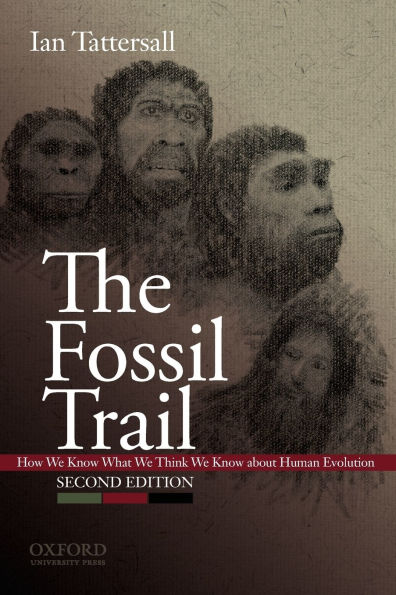The Fossil Trail: How We Know What We Think We Know About Human Evolution
Extensively revised and updated, the second edition of The Fossil Trail: How We Know What We Think We Know About Human Evolution offers a colorful history of fossil discoveries and a revealing insider's look at how these finds have been interpreted--and misinterpreted--through time. It covers the dramatic increase in the size and scope of the human fossil record as well as new techniques for analyzing and interpreting that record that have emerged in the thirteen intervening years since the first edition's publication. Author Ian Tattersall, Curator in the Division of Anthropology of the American Museum of Natural History, places the researchers and their discoveries within the context of their social and scientific milieus and reveals the many forces that shape our interpretation of fossil findings. The Fossil Trail provides an up-to-the-minute overview of paleoanthropological thought and discovery and presents our "family tree" as it is portrayed in the Spitzer Hall of Human Origins at the American Museum of Natural History.
New to the Second Edition *Revisions throughout bring this edition thoroughly up to date
*New chapters: Chapters 17 and 18 include a discussion of the state of paleoanthropology as the first decade of the 21st century concludes and thoughts on the future of the field
*A new gallery of maps of major fossil sites, in Western Europe, Central Europe, the Caucasus and Near East, East Asia, Northern Africa, and Southern Africa
*Updated opening timeline includes the stratigraphic ranges of twenty-three hominid species
*In addition to over 90 high quality fossil renderings, new photographs illustrate new findings in the field
1101397050
New to the Second Edition *Revisions throughout bring this edition thoroughly up to date
*New chapters: Chapters 17 and 18 include a discussion of the state of paleoanthropology as the first decade of the 21st century concludes and thoughts on the future of the field
*A new gallery of maps of major fossil sites, in Western Europe, Central Europe, the Caucasus and Near East, East Asia, Northern Africa, and Southern Africa
*Updated opening timeline includes the stratigraphic ranges of twenty-three hominid species
*In addition to over 90 high quality fossil renderings, new photographs illustrate new findings in the field
The Fossil Trail: How We Know What We Think We Know About Human Evolution
Extensively revised and updated, the second edition of The Fossil Trail: How We Know What We Think We Know About Human Evolution offers a colorful history of fossil discoveries and a revealing insider's look at how these finds have been interpreted--and misinterpreted--through time. It covers the dramatic increase in the size and scope of the human fossil record as well as new techniques for analyzing and interpreting that record that have emerged in the thirteen intervening years since the first edition's publication. Author Ian Tattersall, Curator in the Division of Anthropology of the American Museum of Natural History, places the researchers and their discoveries within the context of their social and scientific milieus and reveals the many forces that shape our interpretation of fossil findings. The Fossil Trail provides an up-to-the-minute overview of paleoanthropological thought and discovery and presents our "family tree" as it is portrayed in the Spitzer Hall of Human Origins at the American Museum of Natural History.
New to the Second Edition *Revisions throughout bring this edition thoroughly up to date
*New chapters: Chapters 17 and 18 include a discussion of the state of paleoanthropology as the first decade of the 21st century concludes and thoughts on the future of the field
*A new gallery of maps of major fossil sites, in Western Europe, Central Europe, the Caucasus and Near East, East Asia, Northern Africa, and Southern Africa
*Updated opening timeline includes the stratigraphic ranges of twenty-three hominid species
*In addition to over 90 high quality fossil renderings, new photographs illustrate new findings in the field
New to the Second Edition *Revisions throughout bring this edition thoroughly up to date
*New chapters: Chapters 17 and 18 include a discussion of the state of paleoanthropology as the first decade of the 21st century concludes and thoughts on the future of the field
*A new gallery of maps of major fossil sites, in Western Europe, Central Europe, the Caucasus and Near East, East Asia, Northern Africa, and Southern Africa
*Updated opening timeline includes the stratigraphic ranges of twenty-three hominid species
*In addition to over 90 high quality fossil renderings, new photographs illustrate new findings in the field
108.0
In Stock
5
1

The Fossil Trail: How We Know What We Think We Know About Human Evolution
352
The Fossil Trail: How We Know What We Think We Know About Human Evolution
352Paperback(New Edition)
$108.00
108.0
In Stock

Product Details
| ISBN-13: | 9780195367669 |
|---|---|
| Publisher: | Oxford University Press |
| Publication date: | 11/19/2008 |
| Edition description: | New Edition |
| Pages: | 352 |
| Product dimensions: | 6.10(w) x 9.20(h) x 0.80(d) |
About the Author
What People are Saying About This
From the B&N Reads Blog
